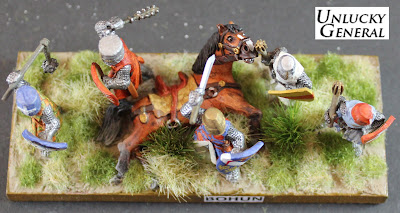London Heraldry: Research
The above London coat of arms is taken from the earliest surviving example from the 16th century and obviously (perhaps) of a construct developed long after the 13th century. Nevertheless, the principle shield device or blazon is understood to be from a much earlier time from 'ancient usage'.
Like so many within the European or christian world, the cult of St. George and the dragon held fast in the imagination of people and clearly the citizenry of London were no exception. The cross of St. George appears to have had a sustained period of adoption from the crusades in Outremer, particularly adopted by the Templars, and endures today in the flag of England. So, I too will be adopting this device for many of my London militia in the left ward under Nicholas de Segrave at Lewes.
Whilst the Guilds dominated the urban social, economic and political landscape of London, specific liveries do not appears to have been an outward feature of organisation or representation until the later middle ages. It appears most unlikely that the armed men of the city would have turned out in the conspicuous colours of their descendants did by the times of the Wars of the Roses. Whilst there are some long standing and dominant guilds such as the cordwainers and fishmongers who 'protected' licence holders and trade more generally, there is no suggestion that they organised for defence of the city separate from one another. In fact, their rights to elect the Mayor from amongst the guilds as well as their own Sheriffs of the city firmly establishes to my mind a united self rule which would have been reflected in the arms an equipment of the guard.
Sylvia Thrupp's study of the London merchant class and Roger Ellis's compilation of seals for the Public Record Office list numerous adoptions of blazons and armourial devices by the burgesses of London: those senior guildmen making up who are sometimes referred to collectively as the 'Barons of London'. Whether granted or assumed, of the 64 heraldic arms identified, none are cited from as early as the 13th century. Remembering that Nicholas de Segrave (a knight of the country) was made the London captain for the Lewes campaign through popular acclamation, it would appear that the men of the London elite were either incapable or disinclined to lead their men beyond the city walls. I would suggest that the London 'Barons' were barons of trade and not of the martial variety.
So, I have my cross of St. George and may mix it up a little with the sword featured in the first quadrant only and a few bare or natural shields with the white cross field sign. Below is my figure for Henry Sandwich, Bishop of London who I have made a fighting bishop for my army. I could find no ecclesiastic heraldry for the London bishopric and so felt free to adopt that of London in full, including the sword aloft.
Resources
- Sylvia Thrupp: The Merchant Classs of Medieval London (Chicago 1948)
- Catalogue of Seals in the Public Record Office (compiled by Roger Ellis, 1978-81, HM Stationery Office)
- David Carpenter The Struggle for Mastery: The Penguin History of Britain 1066-1284 (2003)





Comments